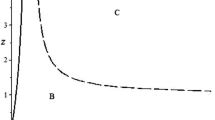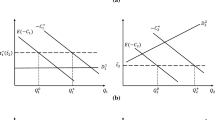Abstract
In many industries firms affect the environment in two distinct types of ways. Firstly they emit routine, anticipated volumes of “flow pollutants”, secondly they can potentially inflict catastrophic environmental damage, liability for which may be overhanging or limited by the law. Operaters of chemical plants, nuclear power stations and oil tankers are three examples. If an emissions tax or charge is to be levied on the flow pollutants in these cases how should it be set? We use simple dynamic-programming techniques to characterise second-best optimality. We identify contexts in which the tax should be raised above its Pigovian level to take account of the catastrophic potential, and others where it should be set below that level. The analysis has significant implications for how policymakers should go about calibrating “ecological taxes” in a number of high profile industries.
Similar content being viewed by others
References
BaumolW. J. and W. E.Oates (1988), The Theory of Environmental Policy, Cambridge University Press, Cambridge, U.K.
BeardT. R. (1990), ‘Bankruptcy And Care Choice’, Rand Journal of Economics 21(4), 626–634.
BranderJ. A. and T. R.Lewis (1986), ‘Oligopoly and Financial Structure: The Limited Liability Effect’, American Economic Review 76, 956–970.
Chemical Week (1982), ‘Why Small Companies Will Survive’ 131 (December), 60.
Coffee, J. (1981), ‘No Body to Damn, No Soul to Kick: An Unscandalised Inquiry into the Problem of Corporate Punishment’, Michigan Law Review 661.
Epstein, R. A. (1982), ‘Manville: The Bankruptcy of Product Liability Law’, Regulation 6 (September).
KraakmanR. H. (1986), ‘Gatekeepers: The Anatomy of a Third-Party Enforcement Strategy’, Journal of Law Economics and Organisation 2(1), 53–104.
Mayshar, J. (1977), ‘Should the Government Subsidize Risky Investment Projects?’, American Economic Review 62(2).
RinglebA. H. and S. N.Wiggins (1989), ‘Institutional Control for Large-Scale, Latent Hazards’, Manuscript, A&M University, College Station, Texas.
RinglebA. H. and S. N.Wiggins (1990), ‘Liability and Large-Scale, Long-Term Hazards’, Journal of Political Economy 98(3), 574–595.
RoeM. J. (1986), ‘Corporate Strategic Reaction to Mass Tort’, Virginia Law Review 72 (February), 1–59.
Segerson, K. (1990), ‘Institutional Markets: The Role of Liability in Allocating Environmental Resources’, Proceedings of an AERE workshop on natural resource mechanism.
SegersonK. (1993), ‘Liability Transfers: An Economics Assessment of Buyer and Lender Liability’, Journal of Environmental Economics and Management 24, 46–63.
SegersonK. and T. H.Tietenberg (1992), ‘The Structure of Penalties in Environmental Enforcement: an Economic Analysis’, Journal of Environment Economics and Management 23, 179–200.
SchwartzA. (1985), ‘Product Liability, Corporate Structure and Bankruptcy: Toxic Substances and the Remote Risk Relationship’, Journal of Legal Studies 14, 45–58.
ShavellS. (1984), ‘A Model of the Optimal Use of Liability and Safety Regulations’, Rand Journal of Economics 15, 271–280.
ShavellS. (1986), ‘The Judgement Proof Problem’, International Review of Law and Economics 6, 45–58.
StiglitzJ. E. and A.Weiss (1983), ‘Incentive Effects of Terminations’, American Economic Review 73, 912–927.
Strand, J. (1992), ‘Environmental Accidents under Moral Hazard and Limited Firm Liability’, Working Paper #22, Department of Economics, University of Oslo.
SummersJ. (1983), ‘The Case of the Disappearing Defendant: An Economic Analysis’, University of Pennsylvania Law Review 132, 145–185.
Author information
Authors and Affiliations
Additional information
I would like to thank Dennis Snower, Sandeep Kapur, Catherine Liston, Robert Cairns, Ngo van Long, two referees of this journal and seminar participants at the University of London and McGill University in Montreal, for useful comments on an earlier draft. All errors are mine.
Rights and permissions
About this article
Cite this article
Heyes, A.G. Optimal taxation of flow pollutants when firms may also inflict catastrophic environmental damage. Environ Resource Econ 7, 1–14 (1996). https://doi.org/10.1007/BF00420424
Issue Date:
DOI: https://doi.org/10.1007/BF00420424




